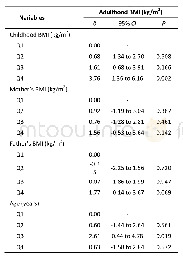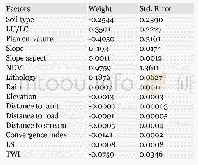《Table 3.Multivariate Linear Regression Model to Evaluate the Effect of Childhood BMI and Parental B
 提示:宽带有限、当前游客访问压缩模式
提示:宽带有限、当前游客访问压缩模式
本系列图表出处文件名:随高清版一同展现
《Childhood BMI and Adult Obesity in a Chinese Sample:A 13-Year Follow-up Study》
Note.Q,quartile.Adjusted for age,sex,parental BMI at baseline,and household income.
The continuous increases in the prevalence of adult and child obesity have become a serious public health concern.Both genetic and environmental factors contributed to the development of obesity from childhood to adulthood[19-21].However,data on the prevalence of obesity among populations from China,which has the largest population and has been undergoing a dramatic socioeconomic transition,are limited.Our findings showed that childhood BMI was a strong predictor of adulthood BMI and obesity status.Table 2 shows that 80%of obese children remain obese when they grow up.Table 3 and Figure 2 show that obese children had the tendency to remain obese when they reach adulthood.These results were consistent with those of previous studies[20,22-25],which were mostly from high-income countries.Our study provides further evidence regarding the prevalence of obesity in middle-income countries and supports the concept that obesity begins in childhood and tends to persist into adulthood[26,27].
| 图表编号 | XD0041620900 严禁用于非法目的 |
|---|---|
| 绘制时间 | 2019.03.20 |
| 作者 | LIU Dan、HAO Yun Xia、ZHAO Ting Zhi、SONG Peng Kun、ZHAI Yi、PANG Shao Jie、ZHAO Yan Fang、ZHANG Mei、WANG Zhuo Qun、MI Sheng Quan、WANG Yu Ying、ZHANG Jian、ZHAO Wen Hua |
| 绘制单位 | National Institute for Nutrition and Health,Chinese Center for Disease Control and Prevention、Yangcheng Center for Disease Control and Prevention、Heshun Center for Disease Control and Prevention、National Institute for Nutrition and Health,Chinese Center f |
| 更多格式 | 高清、无水印(增值服务) |
查看“Table 3.Multivariate Linear Regression Model to Evaluate the Effect of Childhood BMI and Parental BMI on Adulthood BMI (”的人还看了
-

- Table 1 The top candidate co-occurrence occupancy models(ΔAIC<2)used to evaluate the effect of environmental variables a





